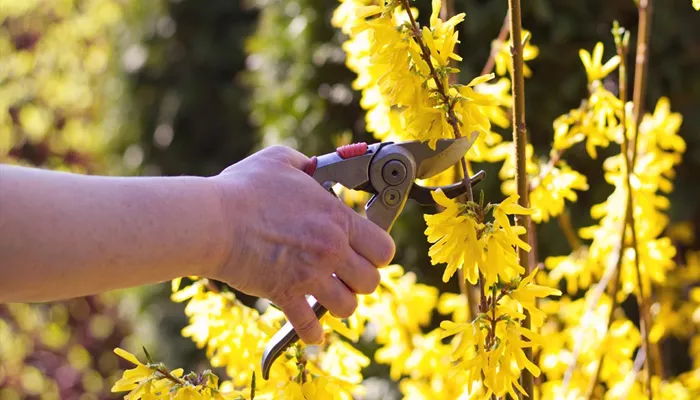Forsythia bushes are a popular choice for gardeners looking to add bright yellow blooms to their spring landscapes. These fast-growing shrubs are known for their vibrant flowers that appear early in the season, signaling the arrival of warmer weather. However, proper pruning is essential to ensure that your forsythia blooms optimally and remains healthy year after year. In this article, we’ll explore when to prune forsythia bushes and provide expert tips for achieving the best bloom possible.
Why Pruning Forsythia Is Important
Pruning forsythia is not just about maintaining the shape and size of the bush; it is also crucial for promoting healthy growth and enhancing flowering. Forsythias bloom on old wood, meaning they produce flowers on stems that grew the previous year. By pruning at the right time, you can ensure that the shrub has enough old wood to produce those beautiful yellow flowers. Pruning also removes dead or damaged branches and encourages new growth, helping your forsythia thrive.
When To Prune Forsythia Bushes
1. Prune Immediately After Blooming
The best time to prune forsythia is immediately after it finishes blooming, typically in late spring. This is because forsythia flowers appear on old wood, meaning if you prune too late in the year, you could be cutting off the branches that would have produced flowers next season.
Pruning after blooming ensures that the plant has time to set new buds for the following year. If you wait too long, you risk cutting off the growth that would have formed next year’s flowers.
2. Early Spring Pruning Is a No-Go
Avoid pruning forsythia bushes in early spring, especially just before or during the bloom period. Doing so can result in cutting off the buds that are already in place for the current year’s blooms. Early spring pruning can also stress the plant, as it interrupts the natural growth cycle.
3. Summer and Fall Pruning – Not Recommended
It’s best to avoid pruning forsythia bushes in the summer or fall. If you prune too late in the growing season, it can stunt the plant’s growth and prevent it from developing the necessary wood for blooming the following year. Pruning in the fall can also expose the bush to winter weather, potentially damaging the shrub during the colder months.
How to Prune Forsythia for Optimal Blooming
1. Remove Dead or Damaged Wood
When pruning your forsythia, always begin by removing any dead, damaged, or diseased wood. Look for branches that are broken or have signs of rot. Cutting these branches will improve the overall health of the plant and prevent the spread of disease.
2. Thin Out Old Wood
To promote new growth and better blooms, it is important to thin out some of the older wood. Forsythia tends to grow in a dense, bushy manner, which can block sunlight from reaching the interior of the plant. By removing some of the older, thicker branches, you allow better airflow and light penetration, which encourages healthier growth.
Cutting back old wood also helps the plant focus its energy on producing new growth, which will bear the most flowers. Be sure to leave some of the older branches intact to ensure the bush continues to bloom.
3. Cut Back Leggy or Overgrown Branches
If your forsythia has become leggy or overgrown, it is time to trim back those long, unruly branches. These branches may not flower as much, and they can also create an unsightly appearance. Cutting them back will improve the overall shape of the bush and allow for new, more productive growth.
When trimming leggy branches, cut them back to a healthy bud or branch. This will encourage new shoots to grow, which will result in more flowers the next season.
4. Don’t Over-Prune
While it’s important to prune forsythia, it’s equally important not to overdo it. Removing too much wood can result in a bush that lacks the necessary old growth for flowering. Try to limit pruning to about one-third of the plant’s size each year. This way, you’ll maintain a healthy balance between old and new wood, which is essential for optimal blooming.
5. Use Sharp, Clean Tools
When pruning forsythia, always use sharp, clean pruning shears or loppers. Clean cuts will heal faster and reduce the risk of disease entering the plant. Make sure your tools are sanitized before you begin pruning to avoid transferring any pathogens.
Common Mistakes to Avoid When Pruning Forsythia
1. Pruning at the Wrong Time
Pruning at the wrong time can severely affect the blooming of your forsythia. As mentioned earlier, it’s important to prune right after the blooms fade, typically in late spring. Waiting too long will result in the loss of next year’s flowers.
2. Cutting Back Too Much
It’s easy to get carried away when pruning, but cutting too much can harm the plant. Avoid cutting back the entire bush, as this will leave it with no old wood to produce flowers. Remember, you should only prune up to one-third of the plant at a time.
3. Failing to Thin Out the Plant
Many gardeners focus on just cutting back the length of the branches, but thinning out the interior of the plant is just as important. Removing older, overcrowded branches will improve airflow and sunlight penetration, leading to healthier growth and better blooms.
Conclusion
Pruning forsythia bushes is an essential part of maintaining their health and ensuring vibrant spring blooms. By pruning immediately after the plant finishes blooming in late spring, you give the shrub ample time to set buds for next year. Regularly remove dead or damaged wood, thin out older branches, and avoid over-pruning to help your forsythia thrive. With the right pruning techniques and timing, you’ll enjoy a stunning display of bright yellow flowers year after year.


